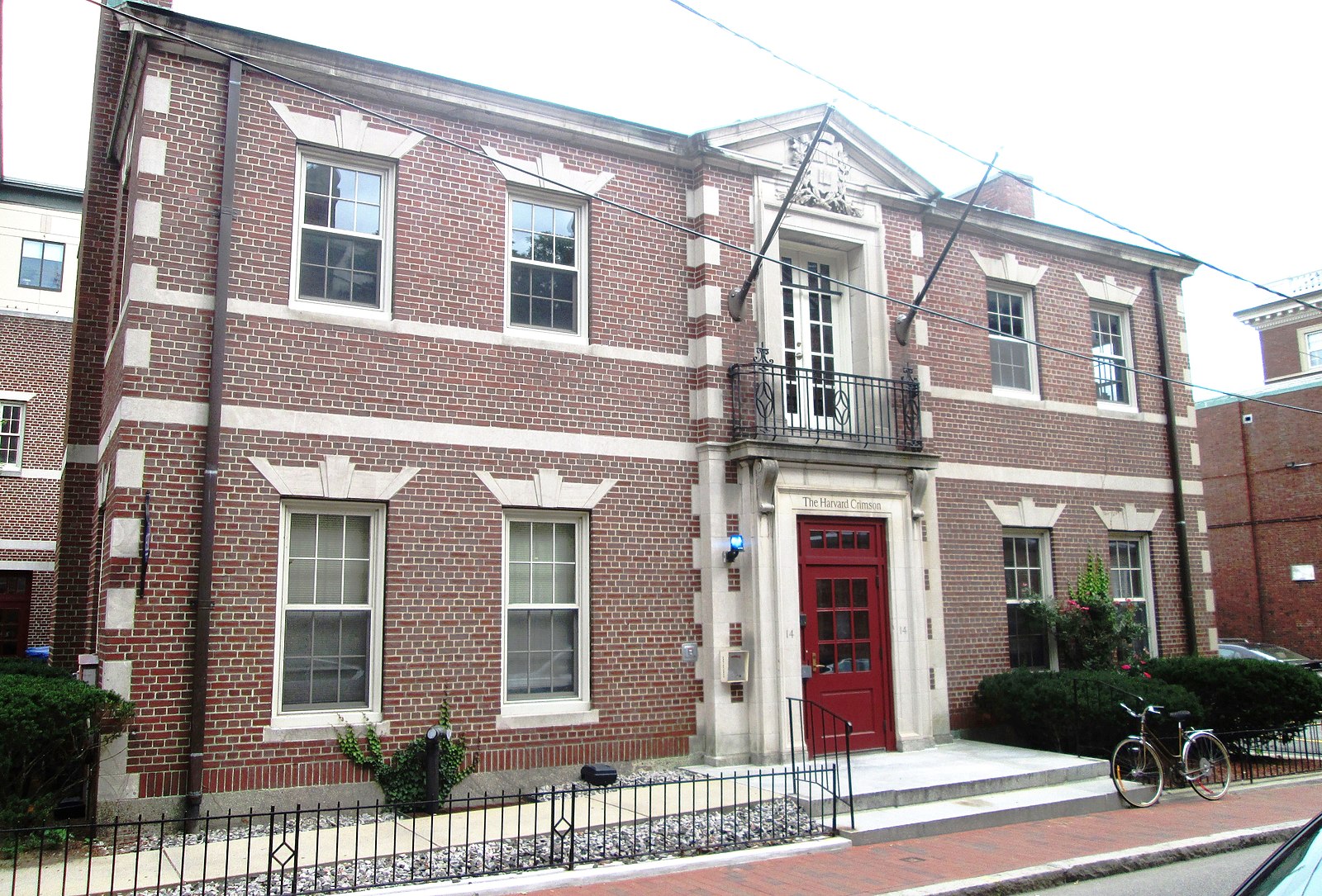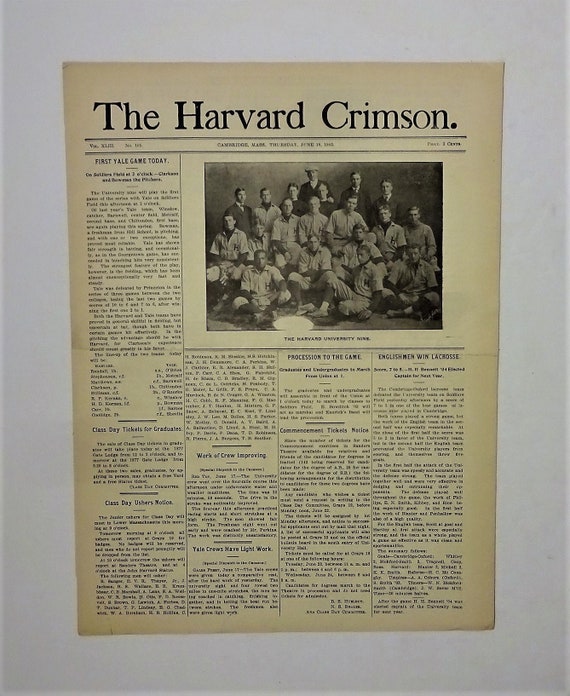The Harvard Crimson: A Beacon Of Student Journalism
When you think about college newspapers, one name shines brighter than the rest: The Harvard Crimson. For over a century, this iconic publication has been shaping the voices of young journalists and making waves both inside and outside Harvard's iconic halls. As we dive into its storied history, you'll discover why this paper isn't just ink on paper—it's a testament to the power of student-driven journalism. So grab your favorite spot, sit back, and let's uncover the incredible legacy of The Harvard Crimson together.
Back in 1873, a group of Harvard students decided it was time to give their peers a voice. And thus, The Harvard Crimson was born. Over the years, it has evolved from a humble student-run publication into a powerhouse of investigative reporting, opinion pieces, and campus news. But what makes it so special? Let me tell you—it's not just about reporting the news. It's about shaping the conversation, holding power accountable, and giving students a platform to express themselves. So, buckle up, because we're about to break it all down for you.
Whether you're a journalism enthusiast, a history buff, or just someone curious about how student newspapers shape public discourse, this article will take you deep into the world of The Harvard Crimson. So let's get started, shall we?
Read also:Did Luke Combs Cast His Ballot For Kamala Harris Unpacking The Connection
Table of Contents
- The Biography of The Harvard Crimson
- The Founding and Early Years
- Impact on Campus Culture
- A Pillar of Journalism
- Notable Alumni
- Challenges Faced by The Crimson
- The Digital Transformation
- Controversies and Criticisms
- The Future of The Harvard Crimson
- Conclusion: Why The Crimson Matters
The Biography of The Harvard Crimson
Key Facts at a Glance
Let's start with the basics. The Harvard Crimson isn't just a campus newspaper—it's a cultural institution. It's been around for so long that it predates many of the modern conveniences we take for granted today. Here's a quick rundown of some key facts:
| Founded | 1873 |
|---|---|
| Location | Cambridge, Massachusetts |
| Publication Frequency | Daily during the academic year |
| Editorial Staff | Completely student-run |
| Website | thecrimson.com |
These facts alone show that The Harvard Crimson isn't your average campus newspaper. It's a powerhouse of information, driven by the passion and dedication of its student staff. For over a century, it's been shaping the minds and voices of young journalists, making it one of the most respected publications in the world.
The Founding and Early Years
Back in 1873, a group of Harvard students saw an opportunity to create something special. They wanted to give their peers a voice, and so The Harvard Crimson was born. At first, it was a weekly publication, covering everything from campus gossip to academic debates. But as the years went on, it evolved into the daily newspaper we know today.
One of the coolest things about The Crimson's early years? It was one of the first student newspapers to adopt a subscription model, which helped fund its operations. This entrepreneurial spirit has stayed with the paper ever since, allowing it to grow and adapt to the changing world of journalism.
Impact on Campus Culture
So, how exactly does The Harvard Crimson influence campus life? Let's break it down:
- Student Voice: The Crimson gives students a platform to express their opinions on everything from campus policies to global issues. It's a place where students can speak their minds and be heard.
- Accountability: The paper holds university administration accountable through investigative journalism. If there's a story that needs to be told, The Crimson is there to tell it.
- Community Building: By covering events, sports, and cultural happenings, The Crimson helps foster a sense of community among students. It brings people together and creates a shared experience.
It's not just about reporting the news—it's about shaping the conversation. And that's where The Crimson truly shines. It's more than just a newspaper; it's a catalyst for change on campus and beyond.
Read also:Exploring The World Of Vegamovies In A Comprehensive Guide To Online Entertainment
A Pillar of Journalism
What Makes It Stand Out?
In a world where journalism is constantly evolving, The Harvard Crimson remains a pillar of integrity and quality reporting. Here's why:
- Student-Run Excellence: Despite being run entirely by students, the paper maintains professional standards. These young journalists are held to the same high standards as professionals in the field, and they rise to the occasion every time.
- Innovative Storytelling: From multimedia features to in-depth investigations, The Crimson pushes the boundaries of traditional journalism. They're not afraid to try new things and tell stories in fresh and exciting ways.
- Global Reach: Its stories often reach far beyond Harvard's campus, influencing national and international discussions. The Crimson isn't just a campus newspaper—it's a global voice for student journalism.
And let's not forget the Pulitzer Prize-winning reporting that has come out of this paper. Yes, you read that right—The Crimson has produced some of the best journalists in the world. It's a testament to the talent and dedication of its student staff.
Notable Alumni
Okay, here's where things get really interesting. The Harvard Crimson has been the training ground for some of the most influential names in journalism. Let's name a few:
- John F. Kennedy: Yup, the 35th President of the United States was once a Crimson editor. Imagine that—future world leaders cutting their teeth in student journalism.
- Robert Coles: Pulitzer Prize-winning author and psychiatrist. His work has inspired generations of readers and thinkers.
- Leonard Downie Jr.: Former executive editor of The Washington Post. He helped shape one of the most respected newspapers in the world, and it all started at The Crimson.
These are just a few examples of the incredible talent that has passed through The Crimson's doors. The paper has a long history of producing world-class journalists, and that tradition continues to this day.
Challenges Faced by The Crimson
Of course, no journey is without its challenges. Over the years, The Harvard Crimson has faced its fair share of obstacles:
- Financial Struggles: Like many newspapers, The Crimson has had to navigate the changing economics of journalism. It's not easy running a newspaper, especially when the world around you is constantly changing.
- Political Pressure: Being a campus newspaper means dealing with the delicate balance of free speech and university politics. It's a tricky line to walk, but The Crimson does it with grace and integrity.
- Technological Changes: Keeping up with the digital age has been a constant challenge. But The Crimson has risen to the occasion, embracing new technologies and finding innovative ways to tell stories.
But through it all, The Crimson has remained resilient, adapting and evolving to meet the needs of its readers. It's a testament to the dedication and passion of its student staff.
The Digital Transformation
In the age of the internet, The Harvard Crimson has embraced digital technology with open arms. Here's how:
- Online Presence: The paper now publishes daily updates on its website, reaching a global audience. It's not just for Harvard students anymore—it's for anyone who wants to stay informed.
- Social Media: Platforms like Twitter and Instagram have become key tools for engaging with readers. The Crimson uses these platforms to connect with its audience and share its stories in real-time.
- Multimedia Content: Videos, podcasts, and interactive features have become staples of The Crimson's digital offerings. It's a multimedia powerhouse, using every tool at its disposal to tell stories in fresh and exciting ways.
This transformation has allowed The Crimson to stay relevant in an ever-changing media landscape. It's a testament to the adaptability and creativity of its student staff.
Controversies and Criticisms
No publication is perfect, and The Harvard Crimson is no exception. Here are a few controversies it's faced:
- Bias Accusations: Some have accused the paper of having a political bias, though its staff maintains a commitment to impartial reporting. It's a delicate balance, but one that The Crimson takes seriously.
- Censorship Concerns: There have been instances where the administration has tried to influence the paper's content. But The Crimson has always stood firm, committed to its mission of truth and transparency.
Despite these challenges, The Crimson continues to push forward, committed to its mission of truth and transparency. It's not always easy, but it's worth it.
The Future of The Harvard Crimson
Looking ahead, the future of The Harvard Crimson looks bright. With a new generation of student journalists ready to take the reins, the paper is poised to continue its legacy of excellence.
Some key areas of focus for the future include:
- Expanding Digital Reach: More investment in digital platforms to reach a wider audience. The Crimson isn't just for Harvard students anymore—it's for anyone who wants to stay informed.
- Diversity and Inclusion: Ensuring that the voices of all students are represented in its pages. It's important that The Crimson reflects the diversity of the Harvard community and beyond.
- Innovative Storytelling: Embracing new technologies to tell stories in fresh and exciting ways. The Crimson has always been at the forefront of journalism, and it plans to stay there.
The Harvard Crimson is not just a newspaper—it's a movement. And its future is as bright as ever.
Conclusion: Why The Crimson Matters
As we wrap up this deep dive into The Harvard Crimson, it's clear that this publication is more than just a campus newspaper. It's a symbol of student power, a champion of free speech, and a beacon of journalistic integrity.
So, what can you do? If you're a reader, keep supporting student journalism by reading and sharing The Crimson's stories. If you're a student, consider getting involved—there's no better way to learn the craft than by doing it yourself. The Crimson is a place where you can make a difference, where your voice can be heard.
And remember, the legacy of The Harvard Crimson isn't just about the past—it's about the future. With each new generation of journalists, the paper continues to evolve and grow, proving that student voices matter more than ever.
So go ahead, check out The Crimson today. You won't regret it!


